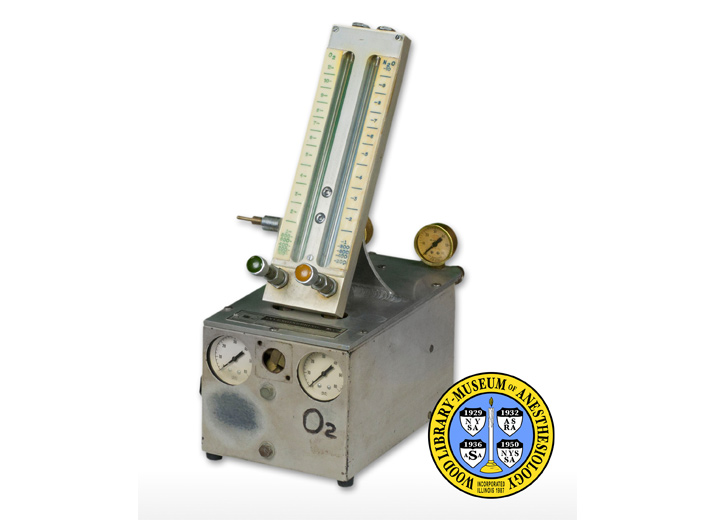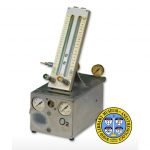Lee Fail-Safe Device
Arnold St. Jacques Lee (1921-2001) was a medical engineer and designer who worked with several anesthesiologists at the Presbyterian Hospital and at Columbia University, in New York City. Together, they developed this prototype of the first device to protect patients from being given anesthetic gas without oxygen. The article that announced and first described this apparatus was published in 1962. Oxygen safety devices developed since are known by many different names, including "oxygen failure safety device," "low-pressure guardian system," and "nitrous oxide shutoff valve." Such oxygen safety functions have been a required component of continuous-flow anesthesia machines since 1979. This prototype was donated to the WLM in honor of inventor Arnold Lee by Robert Epstein, M.D.
Catalog Record: Lee Fail-Safe Device
Access Key: aihb
Accession No.: 2003-07-02-01
Title: [Lee fail-safe device / designed by Arnold Lee.]
Author: Lee, Arnold S. J. (St. Jacques), 1921-2000.
Author: Epstein, Robert M.
Author: Rackow, Herbert.
Author: Papper, E.M. (Emanuel Martin), 1915-2002.
Title variation: Alt Title
Title: Lee failsafe apparatus.
Title variation: Alt Title
Title: Lee’s fail safe device.
Title variation: Alt Title
Title: Oxygen failure safety device.
Title variation: Alt Title
Title: “Master-salve” proportioning regulator system.
Title variation: Alt Title
Title: Lee failsafe prototype.
Publisher: Belmar, N.J. : Invengineering, Inc., [1959?].
Physical Description: 1 anesthesia apparatus : aluminum, steel, brass, copper, other metals, glass, plastic ; 39 x 17.5 x 30 cm.
Subject: Oxygen Failure Safety Device.
Subject: Equipment Safety.
Subject: Nitrous Oxide.
Note Type: General
Notes: Title is based on the 1962 article by RM Epstein, H Rackow, ASJ Lee, and EM
Paper that described the new device, as well as a 2003 unpublished summary by
Dr. Epstein titled, “Notes on Arnold Lee’s Original ‘Fail Safe’ Device.”
Note Type: With
Notes: Received with a black, rubber, oxygen hose attached.
Note Type: Citation
Notes: American National Standards Institute: Minimum Performance and Safety
Requirements for Components and Systems of Continuous Flow Anesthesia
Machines for Human Use. (ANSI Z79.81979). New York, American National
Standards Institute, 1979.
Note Type: Citation
Notes: Dorsch JA, Dorsch SE. Understanding Anesthesia Equipment, 5th ed.
Philadelphia: Wolters Kluwer/Lippincott Williams & Wilkins, 2008:99.
Note Type: Citation
Notes: Epstein RM, Rackow H, Lee ASJ, Papper EM. Prevention of accidental breathing
of anoxic gas mixtures during anesthesia. Anesthesiology. 1962;23(1):1-4.
Note Type: Citation
Notes: Epstein RM. Notes on Arnold Lee’s original “fail safe” device. Unpublished
document. June 2003. Located at: The Wood Library-Museum of Anesthesiology,
Park Ridge, IL.
Note Type: Citation
Notes: Gribbin JH, Krogfus SS. Industrial Research Laboratories of the United States
10th ed. Washington D.C.: National Academy of Sciences, 1960.
Note Type: Citation
Notes: Kofkew A. Focus on: Robert M. Epstein, M.D. AUA Update. Winder 2004:1-9.
Note Type: Physical Description
Notes: A working prototype, oxygen failure safety device; The mechanical hardware
for the system is housed in a rectangular, aluminum shell, forming the base
of the apparatus; Some of the internal hardware is visible from a large open
area in the base of the unit; The exterior of the instrument has visible wear
indicating considerable use; Two gas input connectors are at the back of the
base; Each input connector bears a threaded tap and a Shrader-type fitting;
The left input connector is for oxygen and the right for anesthetic gas
(position based on a frontal view); The top of the base of the instrument
extends in back, like a shelf, a few cm beyond the back side of the base, and
above the connectors; On the shelf, just above each inlet connector are two
brass, round, pressure gauges; The gauges face forward and display the flow
of gas in psi from 0 to 60; “O2” is marked in indelible ink and large letters
on top of the base, just in front of the left gauge; A scalloped, black,
plastic, control knob extends from the left side of the base, near the front;
Through two round openings on the front side of the base, the faces of
another two pressure gauges are visible; These two gauges also display the
flow of gas in psi from 0 to 60; “O2” is marked in indelible ink, in large
letters, below the gauge on the right; Between the gauges is a round opening;
A rectangular marking around the opening, and two small drill holes, give the
impression that a plate was once held over the area; A long, rectangular,
metal unit, that houses two flow meters, sits atop the base and leans toward
the back at about a 35 degree angle; Behind the flowmeter unit is its
supporting brace; The brace is welded perpendicularly into the top of the
base; The flowmeters and markings are in the front, or face, of the unit;
Evenly spaced markings to the left of the left flowmeter indicate L/min from
0, at the bottom, to 11 at the top; “O2” is marked just above 11; The tube of
the left flowmeter has a green background; Evenly spaced markings to the
right of the right flowmeter indicate L/min, with 0 at the bottom and 10 at
the top; “N2O” is marked just above 10; The tube of the right flow meter has
a blue background; A control knob with a green face extends from the
flowmeter unit just below the O2 flowmeter; Similarly, an orange-faced knob
extends out just below the anesthetic gas flowmeter; A copper outlet tube
extends from the left side of the flowmeter unit; Manufacturer’s markings are
on a metal plate screwed to the top of the base, just in front of the
flowmeter unit; To the right of the Ivengineering, Inc. logo is,
“INVENGINEERING, INC. [new line] BELMAR NEW JERSEY U.S.A. [new line] MODEL
169 SERIAL 1”.
Note Type: Physical Description
Notes: Photographed by Mr. William Lyle, 7/14/2010.
Note Type: Acquisition
Notes: Donated to the WLM by Robert M. Epstein, M.D., 2/7/2003, along with a black,
rubber, oxygen hose, and a laminated, letter sized, double sided summary of
the device.
Note Type: Historical
Notes: Arnold St. Jacques Lee (1921-2001) was a medical engineer and designer who
worked with several anesthesiologists at the Presbyterian Hospital and at
Columbia University, in New York City, including Robert M. Epstein, Herbert
Rackow, and Emanuel M. Papper (Epstein, et al., 1962; Kofkew, 2004). With
input from the anesthesiologists Lee developed this prototype of the first
device to protect patients from being given anoxic anesthetic gas. Creation
of the safety device was inspired by serious accidents where there was a
failure of the oxygen supply during the administration of anesthesia. Three
such cases are shared in the 1962 article that announced and first described
this apparatus (Epstein, Rackow, Lee, Papper, 1962). This first device was
designed to shut off the flow of anesthetic gas if the flow, or pressure, of
O2 diminished or halted. It was still up to the anesthesiologist to notice
that there was no longer a flow of anesthetic gas. Devices developed since
this first fail-safe are known by many different names, including “oxygen
failure safety device”, “low-pressure guardian tem”, and “nitrous oxide
shutoff valve” (Dorsch, Dorsch, 2008). Such oxygen safety functions have
evolved and become a required component of continuous-flow anesthesia
machines since 1979 (American National Standards Institute, 1979).
Note Type: Historical
Notes: During the development of the fail-safe device the designer, Arnold St.
Jacques Lee, was the chief medical engineer and director of research and
technical personnel at the research laboratory Invengineering, Inc. (Gribbin,
Krogfus, 1960).



